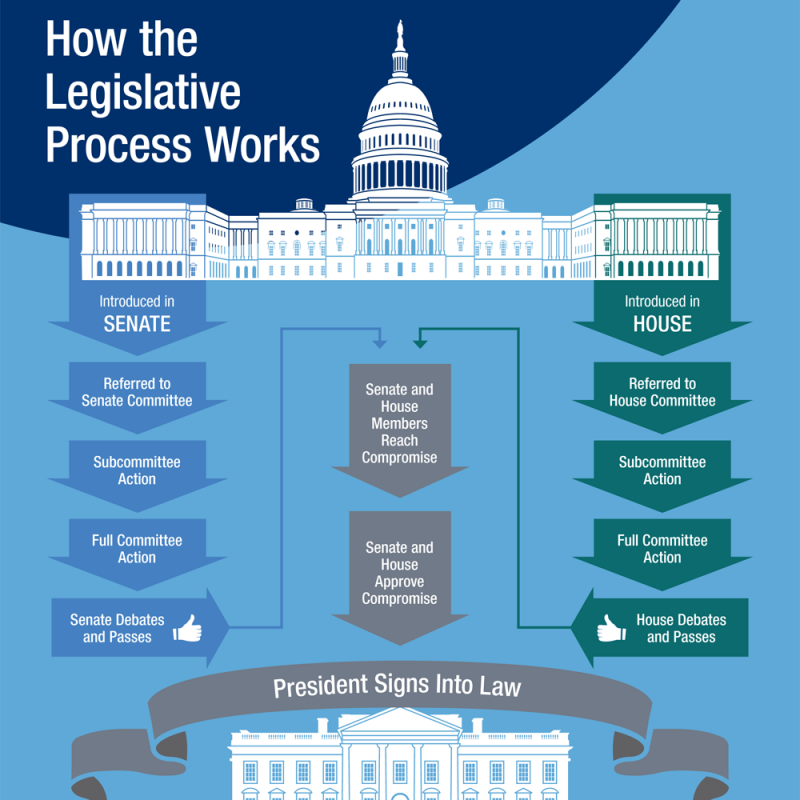When a member agrees to “cosponsor” a bill, he or she adds their name to the list of members who are on record in support of the legislation.
To hear Schoolhouse Rock tell it, introducing a bill is easy:
“Some folks back home decided they wanted a law passed, so they called their local Congressman and he said, ‘You’re right, there oughta be a law.’ Then he sat down and wrote me out and introduced me to Congress. And I became a bill, and I’ll remain a bill until they decide to make me a law.”
Introduced me to Congress. Less than a sentence. But what happens between writing legislation and introducing it to Congress often shapes how — and whether — it’ll change policy.
Cosponsors are key to moving policy forward.
As Policy Associate Emily Wirzba put it, “Cosponsors are saying that, not only do they agree with the words of the bill, but they’re also deeply committed to it. They want to take steps to advance the legislation, including talking to their colleagues about it. They’re signaling that the policy is a priority for their office.”
The names on the bill when it is introduced — its “original cosponsors” — are particularly important in shaping the bill’s fate. How many are there? Is this a partisan issue, with only Democrats or only Republicans listed, or is it bipartisan? Are leaders in the committee the bill will need to pass through on the list? This information tells congressional leadership how much momentum is behind a bill. A strong list of cosponsors can make the difference between a bill that gets a vote and a bill that dies in committee.
That’s why we often work hard to build a strong list of original cosponsors, even before the bill is introduced. As Theo Sitther, legislative secretary for peacebuilding policy, says, “We want to give a bill the best chance we can of moving forward. That means building consensus and getting cosponsors from both parties.” Allyson Neville-Morgan, legislative associate for preventing violent conflict, adds, “There are bottlenecks throughout the legislative process, and cosponsors help keep legislation moving forward.”
Cosponsoring a bill can be a pretty heavy lift, and it can take months or even years of advocacy for a member of Congress to cosponsor legislation — that’s where constituents come in. While she was helping to build support for the Gibson resolution on climate change, Emily remembers a group of middle school students as the turning point for one member of Congress signing on. And Sen. Thom Tillis agreed to cosponsor the Genocide and Atrocities Prevention Ac after a group of Quakers lobbied him during Annual Meeting 2015.
But all that work pays off. Here’s what cosponsors might be telling the rest of Congress:
1. This isn’t a partisan issue.
Many issues are associated with Democrats or Republicans. But finding one or more cosponsors from the unexpected party can help reframe the issue as nonpartisan.
2. The right people are involved.
Members of Congress are all on committees which give them particular power over certain issues. Someone on the Senate Foreign Relations Committee, for example, could be a key ally on peacebuilding policy, but they might not be as powerful on climate.
3. We’re paying attention to this issue.
Emily notes that cosponsors of the Gibson resolution have formed a small but powerful Republican voting bloc in support of climate action.
And a bill isn’t actually just a bill.
Right now, it’s really difficult to get bills signed into law. But getting a bill or resolution introduced with a strong set of cosponsors can help shape policy going forward in a few ways:
- Cosponsors can become cultivate future champions who will help move the issue forward.
- Pieces of the legislation can come up for a vote as an amendment to another major spending or policy bill.
- The president can use support for an idea to inform executive action.
- Members of Congress can bring back ideas from years past and use earlier support to gain traction.
- Constituents can use the newly introduced legislation as a way of talking to Congress about the issues that matter to them.
The takeaway
It’s not easy to get a bill or resolution introduced, but it’s worth it. Introducing legislation with a strong list of cosponsors can help build momentum around an idea, and that one important way that change happens.


